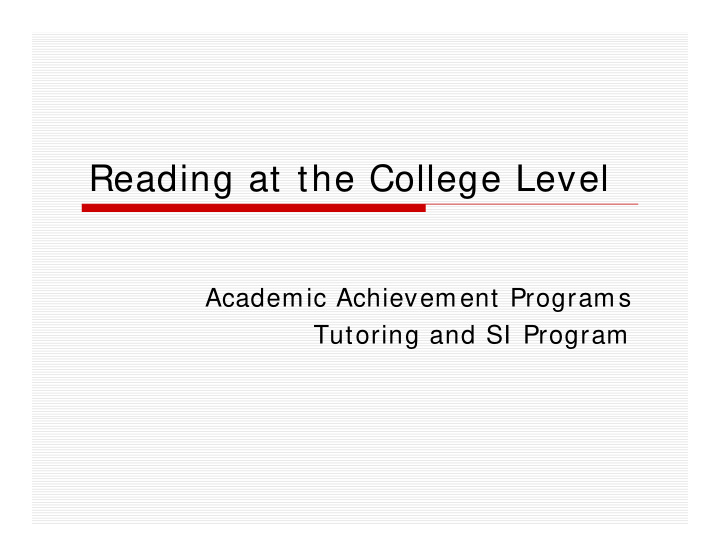



Reading at the College Level Reading at the College Level Academic Achievement Programs Tutoring and SI Program
Reading at the College Reading at the College Level
Active Reading B Benefits fit Activates schema (background knowledge) knowledge) Enhances comprehension Fosters metacognition Fosters metacognition Helps to improve memory Keeps the reader’s attention focused Keeps the reader s attention focused
Seven Steps to Active Reading Pre read Pre-read Read Highlight Highlight Paraphrase Margin note Margin note Chunk Summarize Summarize
Step 1: Pre-read For textbook reading: For textbook reading: Read the title Read the chapter outline Read the introduction and/ or first paragraph Read the introduction and/ or first paragraph Read the summary and/ or last paragraph Read the end-of chapter aids Read the headings and subheadings Read the headings and subheadings Study pictorial aids Notice important terminology
Step 2: Read Questions to ask yourself while you are reading Questions to ask yourself while you are reading What is the author’s THESIS? What are the MAIN IDEAS presented in the selection? What is the author’s TONE? What MOOD is the author trying to convey? What is the author’s BIAS? What INFERENCES do I draw from the reading? Did the author accomplish his/ her PURPOSE? How would I EVALUATE the piece?
Step 3: Highlighting Highlight main ideas only. Hi hli ht i id l Mark details when reading scientific or historical information (i.e. hi t i l i f ti (i processes, chronological dates, etc.) M Mark unfamiliar vocabulary k f ili b l Use highlighting sparingly.
Step 4: Paraphrase Why paraphrase? Why paraphrase? To restate an idea so you understand it. To restate an idea so someone else understands To restate an idea so someone else understands it. To avoid plagiarizing when writing research papers papers To make review of important information easier. To make a statement simpler or more colorful.
How to Paraphrase St Step one: Find accurate synonyms for key words in the passage or sentence the passage or sentence. Step two: Rearrange the structure without Rearrange the structure without changing the meaning.
Step 5: Margin Noting T To margin note i t Write in the margin of your textbook (or index cards if you are using a library index cards if you are using a library book) the main points of the section, important terms and theories to p remember, and interesting points which related to your lecture/ class notes.
Step 6: Chunk Why chunk or break up your reading into Why chunk or break up your reading into smaller parts? It is a way to follow the writer’s train of thought. t s a ay to o o t e te s t a o t oug t The reader groups similar main ideas together. It builds on the skill of margin noting. It brings the readers’ awareness to the “big picture”. It can help the reader to the thesis. p
How to ‘Chunk’? Read the material Read the material—begin by margin begin by margin noting the first paragraph; then as you read, decide whether the idea you read, decide whether the idea continues or expands, or if there is a shift to a new thought. Give each chuck a title or write the main idea of each chunk in the margin margin.
Step 7: Summarize Aft After you have finished reading the h fi i h d di th entire selection or chapter, make sure to recap by writing down the most to recap by writing down the most important points, ideas, terms, in your own words your own words.
Strategies for Comprehension Monitoring M Mark where your comprehension k h h i breaks down. Paraphrase each sentence or P h h t paragraph prior to that. R Re-read difficult sections aloud. d diffi l i l d Look up unfamiliar words and see if the definition matches the context.
Strategies for Comprehension Monitoring Chunk related sections of material Chunk related sections of material. Margin note. Write guiding questions and attempt to find Write guiding questions and attempt to find the answers. Think about your existing schemas—decide Think about your existing schemas decide if you need to research the topic. Read with a study partner and discuss ideas.
References M Wh McWhorter, Kathleen T. (2007). Reading t K thl T (2007) R di Across the Disciplines: College Reading and Beyond Third Edition Reading and Beyond, Third Edition (Chapter 4 pgs. 67-98). New York, NY: Pearson Longman Publishing NY: Pearson Longman Publishing. Smith, B. (2007). The Reader’s Handbook Third Edition New York Handbook, Third Edition. New York, NY: Pearson Longman Publishing.
Reading at the College Level Reading at the College Level Academic Achievement Programs Tutoring and SI Program
Recommend
More recommend